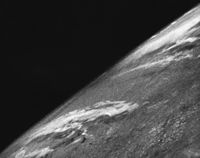
Photo from wikipedia
ABSTRACT Quantitative remote sensing of vegetation biophysical and biochemical parameters through the inversion of physical models is of great significance for monitoring vegetative growth, ecosystem function, and the global carbon… Click to show full abstract
ABSTRACT Quantitative remote sensing of vegetation biophysical and biochemical parameters through the inversion of physical models is of great significance for monitoring vegetative growth, ecosystem function, and the global carbon and nitrogen cycles. However, mapping and comparing vegetation parameters in a tidal saltmarsh based on multi-spectral satellite imagery has been rarely documented. In this study, a coupled model (Soil-Canopy-Observation of Photochemistry and Energy fluxes, SCOPE) was used to quantitatively invert the spatial patterns of key parameters such as the leaf area index (LAI), leaf chlorophyll content (C ab), and fraction of absorbed photosynthetically active radiation (fPAR) of salt marsh vegetation from Land Remote-Sensing Satellite 8 (Landsat-8), Sentinel-2A, and RapidEye multispectral satellite imagery. The results show that RapidEye outperformed Landsat-8 and Sentinel-2A in the retrieval of LAI and C ab, with higher coefficients of determination (R 2 = 0.539 and 0.488, respectively) and lower normalized root mean square errors (NRMSE = 0.32 and 0.28, respectively). Without the red-edge band, the R 2 between the modelled and observed LAI and C ab for RapidEye decreased by 27.83% and 5.33%, respectively, while the NRMSE increased by 3.13% and 46.43%, respectively, highlighting the important role of the red-edge band in vegetation parameter retrieval. Tidal flooding resulted in poor retrieval results from Sentinel-2A. However, the accuracy of C ab inversion was significantly improved by removing the sampling sites near tidal trenches or in low-lying areas, indicating that tidal inundation exerted a notable effect on the retrieval of saltmarsh vegetation parameters when using multi-spectral images. In addition, the spatial pattern of the simulated fPAR from RapidEye is consistent with that of the gross primary productivity. This study provides an alternative method for estimating ecosystem functions in a tidal saltmarsh wetland, as well as for large-scale and high-precision monitoring of wetland restoration that is beneficial for the ecological protection of coastal zones.
Journal Title: International Journal of Remote Sensing
Year Published: 2020
Link to full text (if available)
Share on Social Media: Sign Up to like & get
recommendations!